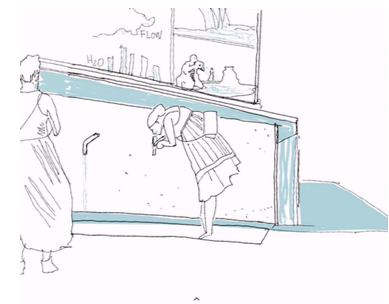This proposed Installation by invitation for the Biennale di Architettura di Venezia addresses the role of water in public space and in the global ecosystem.
Water is the life blood of the city. In its absence we must go out and find it and, through human labor or engineering prowess, bring it to our cities. But once it has served our needs, it continues on its circuit to rivers and seas.
Global migration increasingly tracks water — people flock toward clean water or run from rising sea levels and climate catastrophes.
Where water and people come together, the well or the fountain, this is the place of exchange. Stopping to drink means finding peace (the lion and its prey both drink from the same source).
Water provides the common denominator of human decency. The poorest and the richest both need water. Laborers and land-owners, tourists, immigrants, politicians, priests, and prostitutes all drink from the same fountains.
In a historic moment in which societies are fortifying their boundaries to ebb the flow of people, water passes regardless. (As architects we know how hard it is to stop its natural circulation.)
- Drinking water. People enter the installation space to drink water, water which has — like them —come from afar. The arrival of the water and its departure into the canals of Venice are both dramatic, visible phenomena. A low wall, bent in plan to better create a feeling of enclosure, allows passage of water in a trough above and through separate pipes below. The latter feeds stainless steel nozzles similar to Rome’snasoni, designed for drinking or filling vessels. One or more vertical jets of water may be used to graph data (i.e. higher jet for greater water consumption).
- Quenching thirst for knowledge. While drinking water, visitors also “drink in” knowledge in the form of graphic displays. Two large monitors or projections reflected onto water-washed surfaces display GIS maps of the earth: one showing the flow of water and another the flow of people. Alternating with these maps in video loops will be two other groups of visual content: photos, video and data of 1. water and 2. people. Both will focus on diversity, the various forms water can take (still, peaceful, dramatic, public, personal, etc.) and the variety of ages, ethnicities, genders,social status, etc. of people who come together around water.
- Roma Caput Mundi. Rome is highlighted on the maps and present in the video with its water theatre, its pilgrims, its immigrants, and its tourists, in the videos. Not people separate from water, but people interacting with water. If the final installation layout should suggest it, there may also be a set of 5-10 simple public place proposals by Studio TRA_20 (and colleagues, students, and others) in the form of boards and/or models would illustrate proposals for new fountains and other urban furniture to be presented to Rome’s administration.





